#treatment for eyes in ayurveda
Text
High Myopia Symptoms Type Causes & Treatment
High myopia, also referred to as severe or pathological myopia, is an uncommonly high degree of nearsightedness (myopia). With high myopia, individuals typically exhibit an eyeball that protrudes too far behind the retina instead of directly on it causing light entering to focus in front of it instead of directly onto it and leading to blurred distance vision while near vision may remain clear.
High myopia is defined by refractive errors exceeding -6.00 diopters; however, its severity can differ among individuals, with some experiencing refractive errors of greater than -8.00 or even exceeding -10.00 diopters. It typically appears in children or adolescence and progresses gradually over time.
Regular eye examinations for those suffering from high myopia are essential in monitoring any changes to vision and early identification of potential complications. Sanjeevan Netralaya's Advanced Ayurvedic eye care has achieved impressive results in treating High Myopia. Through their patient-centric approach, personalized treatment plans are meticulously tailored to each individual's specific requirements and pain-free experiences are ensured without discomfort or side effects.

What are the symptoms of High Myopia?
High myopia (or severe myopia) is defined by an unusually high degree of nearsightedness. While its symptoms vary according to each individual, common manifestations include:
· Blurred Distance Vision: When objects in the distance appear blurry or out-of-focus, near vision may still remain clear.
· Difficulty with Distance Vision: People suffering from high myopia often struggle to see distant objects such as street signs, whiteboards and faces from far away.
· Squinting or Eye Strain: Individuals with high myopia often strain their eyes when trying to focus on distant objects clearly, leading them to squint or strain their vision in an attempt to improve their vision.
· Eye Fatigue: Prolonged visual tasks such as reading or using the computer may cause eye fatigue and discomfort for individuals with high myopia.
· Poor distance vision can cause headaches when engaging in activities that require visual focus, leading to frequent headaches as a result of straining eyes.
· Difficulties with Night Vision: High myopia may result in impaired night vision, making it challenging to see clearly in low-light conditions.
· Increased Sensitivity to Glare: People suffering from high myopia may be particularly sensitive to bright lights and glare, leading to discomfort and vision difficulties.
· Squinting or Holding Objects Close: Individuals with high myopia often unconsciously compensate for their blurred distance vision by unconsciously squinting or holding objects closer to their face in order to see them more clearly.
Considerations should be given to the fact that these symptoms could also indicate other eye issues; to receive an accurate diagnosis it is vital to visit an eye care professional for a comprehensive eye examination and diagnosis. Regular check-ups for individuals with high myopia are especially essential in monitoring their eye health and detecting potential complications like retinal detachment or macular degeneration which could result from having such condition.
Sanjeevan Netralaya’s Advanced Ayurvedic eye care stands as a highly effective treatment modality for High Myopia. At Sanjeevan Netralaya, each patient receives personalized attention, benefiting from meticulously crafted treatment plans that are uniquely tailored to address their specific needs. These specialized interventions prioritize patient comfort, offering a painless and comfortable experience, completely devoid of any associated discomfort or side effects.
What are the causes of High Myopia?
The exact causes of high myopia, also known as severe or pathological myopia, are not fully understood. However, several factors have been identified as potential contributors to its development. These causes include:
· Genetic Factors: There is a strong genetic component to myopia, including high myopia. Individuals with who have a family history are more likely to develop high myopia. Multiple genes are believed to play a role in determining the development and progression of myopia.
· Environmental Factors: Environmental factors, such as prolonged near work activities (such as reading, writing, or using electronic devices) and lack of outdoor activities, have been associated with an increased risk of myopia development, including high myopia. Insufficient exposure to natural light and spending excessive time on close-up tasks may contribute to the elongation of the eyeball.
· Structural Abnormalities of the Eye: In individuals with high myopia, the eyeball is often longer than normal, which leads to the focusing of light rays in front of the retina instead of directly on it. Structural abnormalities of the cornea or lens may also contribute to the development of high myopia.
· Imbalance in the Growth of Eye Components: The growth and development of the eye involve complex processes that require a delicate balance. In high myopia, there may be an imbalance in the growth of certain eye components, such as the sclera (the white outer layer of the eye), choroid (the vascular layer beneath the retina), and retina, leading to excessive elongation of the eyeball.
· Hormonal and Systemic Factors: Some studies suggest that hormonal and systemic factors, such as changes during puberty or hormonal imbalances, may influence the development of high myopia. However, further research is needed to establish a clear link.
It's important to note that while these factors are believed to contribute to the development of high myopia, the condition is likely influenced by a combination of genetic and environmental factors. High myopia can also be influenced by individual variations and interactions between these factors. Further research is needed to fully understand the underlying causes of high myopia and its complex interplay with various factors.
Sanjeevan's Advanced Ayurvedic eye care is effective in treating High Myopia. Sanjeevan Netralaya treats each patient with a unique treatment plan. The specialised treatments are tailored to the individual and cause no pain, discomfort, or side effects. It is important to have your eyes examined regularly so book your appointment now!
#High Myopia#health & fitness#ayurveda#eye care#sanjeevan netralaya#india#eyes#eyesight#retina#eye health#ayurvedic eye treatment#ayurvedic treatment
2 notes
·
View notes
Text
78 th Happy Independence Day from Rajah Ayurveda products

Wishing you all a joyous 78th Independence Day from Raja Ayurveda Products! Celebrate this special day by embracing freedom from chemical-laden products. Experience the power of 100% Ayurvedic cream that nourishes your skin from the inside out, reduces dark circles and wrinkles, and enhances your natural glow. This Independence Day, choose Raja Ayurveda for radiant, healthy skin WE ARE INVITING DISTRIBUTORS / DEALERS ALL OVER KERALA wa.me/916282324903
#skincare#self care#ayurveda#ayurvedic#science#panchakarma#amazing body#my face#pretty face#skin#neck#dark eyes#herbalremedies#stressrelief#ayurvedictreatment#ayurvedicmedicine#alternative medicine#herbert west#herbalism#herbal#organic#plantlife#beautiful#sketch#sky#organization#hospital#treatment#trending#medical tourism
0 notes
Text
Ayurveda for Eyecare: Everything You Need to Know
Ayurveda, the ancient Indian system of medicine, offers a holistic approach to health and well-being. When it comes to eye care, Ayurveda provides natural and effective solutions for maintaining and improving vision. At Herbal Park Ayurvedic Clinic, we are dedicated to bringing the wisdom of Ayurveda to your doorstep, ensuring your eyes receive the care they deserve. In this blog, we will explore the fundamentals of Ayurvedic eye care, delve into specific treatments and remedies, and highlight how Herbal Park can support your journey towards optimal eye health.

Ayurvedic Approach To Eye Health
Ayurveda emphasizes the balance of the three doshas—Vata, Pitta, and Kapha—as the key to health. Each dosha represents different bodily functions and characteristics. Imbalances in these doshas can lead to various health issues, including eye problems. Ayurvedic eye care focuses on maintaining this balance through natural remedies, lifestyle adjustments, and dietary changes.
Detoxification
Detoxification is a cornerstone of Ayurvedic medicine. It involves removing toxins (ama) from the body, which can accumulate due to poor diet, stress, and environmental factors. Detoxifying the body helps improve circulation and nutrient delivery to the eyes, thereby enhancing eye health.
Balancing Doshas
Maintaining the balance of Vata, Pitta, and Kapha is crucial for healthy eyes. For example, an excess of Pitta can cause inflammation and redness in the eyes, while an imbalance in Vata can lead to dryness and fatigue. Ayurveda offers specific treatments and lifestyle modifications to balance these doshas.
Nutrition
A nutrient-rich diet is essential for maintaining eye health. Ayurveda recommends consuming foods high in antioxidants, vitamins, and minerals that support eye function. Leafy greens, carrots, and fruits are particularly beneficial.
Herbal Remedies
Ayurveda harnesses the power of herbs to treat and prevent eye conditions. Herbs like Triphala, Amla, and Ginkgo Biloba are known for their positive effects on vision and overall eye health.
Lifestyle Practices
Proper sleep, stress management, and regular eye exercises are integral to Ayurvedic eye care. Practices such as yoga and meditation can significantly contribute to maintaining healthy eyes.
Ayurvedic Treatments for Eye Care
Herbal Park Ayurvedic Clinic offers a range of treatments designed to enhance and protect your vision using the principles of Ayurveda. Here are some of the most effective treatments for eye care:
1. Netra Tarpana
Netra Tarpana is a specialized Ayurvedic treatment that involves bathing the eyes with medicated ghee (clarified butter). This therapy nourishes and rejuvenates the eyes, improves vision, and helps treat conditions such as dry eyes and inflammation.
2. Triphala Wash
Triphala, a combination of three fruits (Amalaki, Bibhitaki, and Haritaki), is highly beneficial for eye health. Washing the eyes with Triphala-infused water detoxifies the eyes, reduces strain, and enhances vision.
3. Herbal Eye Drops
Our clinic offers herbal eye drops made from natural ingredients like rose water, honey, and various herbs. These drops soothe irritation, reduce redness, and prevent infections.
4. Eye Exercises
Regular eye exercises can strengthen eye muscles, improve focus, and reduce eye strain. Techniques such as palming, blinking, and rotating the eyes are commonly recommended in Ayurveda.
5. Diet and Nutrition
A diet rich in antioxidants and vitamins is crucial for maintaining eye health. Herbal Park provides personalized dietary recommendations to ensure you receive the nutrients necessary for optimal eye function.
Ayurveda Eye Care at Herbal Park
At Herbal Park Ayurvedic Clinic, we are committed to providing authentic Ayurvedic care tailored to your unique needs. Here’s how we can help you achieve and maintain healthy eyes:
Comprehensive Consultations
Our experienced Ayurvedic practitioners conduct thorough consultations to understand your specific eye health concerns and overall health status. This assessment allows us to develop personalized treatment plans tailored to your needs.
Specialized Treatments
We offer a range of specialized Ayurvedic treatments for eye care, including Netra Tarpana, Triphala washes, and herbal eye drop therapies. Our treatments are designed to nourish, rejuvenate, and protect your eyes.
Quality Herbal Products
Herbal Park provides high-quality, natural herbal products that are safe and effective. Our range of eye care products includes herbal eye drops, eye washes, and dietary supplements made from pure, organic ingredients.
Nutritional Guidance
Proper nutrition is essential for maintaining healthy eyes. Our Ayurvedic practitioners offer personalized dietary recommendations to ensure you get the right nutrients to support your eye health.
Lifestyle and Stress Management
We believe in a holistic approach to health. Herbal Park provides guidance on lifestyle practices, including stress management techniques, yoga, and eye exercises, to help you maintain optimal eye health.
Ongoing Support
We are dedicated to your long-term well-being. Herbal Park offers ongoing support and follow-up consultations to monitor your progress and make necessary adjustments to your treatment plan.
Conclusion
Ayurveda offers a comprehensive and natural approach to eye care that emphasizes prevention, natural remedies, and lifestyle adjustments. By incorporating Ayurvedic principles and treatments, you can maintain healthy eyes and improve your vision naturally. Herbal Park Ayurvedic Clinic Herbal Park Ayurvedic Clinic is here to guide you on your journey to better eye health with our expert consultations, specialized treatments, and high-quality herbal products. Visit us to experience the benefits of authentic Ayurvedic care and ensure your eyes remain healthy and vibrant.
0 notes
Text
Ayurvedic Mobile Eye Clinic - Sreedhareeyam Ayurveda Eye Hospital
Eye Consultation & Treatments
To know more, Visit Website!
#mobile eye clinic#ayurvedam#ayurveda treatments#eye clinic#mobileclinic#clinic#best ayurveda mobile clinic
0 notes
Text
Effective Ayurvedic Remedies for Under-Eye Dark Circles
Under eye dark circles are a common concern among people. Screen time, stress, job pressure… under eye dark circles can appear due to various reasons. It is true that it downgrades our appearance and confidence but the most frustrating thing about under eye dark circles is ineffective medicines. But don't worry Ayurveda is there for us, it offers various medicines to cure under eye dark circles naturally. For instance Almond oil, rich in vitamin E,which is highly beneficial for skin. It will nourish and moisturize delicate under eye skin.Cucumber Slices: highly beneficial against dark circles under the eye because of its cooling properties. Rose water; it can produce a soothing effect on the skin and it helps you to lighten dark circles. Turmeric: it is known for its anti-inflammatory and skin brightening properties. Amla: it contains vitamin c,which will help you to lighten the dark circles. Coconut oil: it is a good moisturizing agent that helps you to reduce dark circles and wrinklesAyurvedic Eye Creams: There are many Ayurvedic eye creams Available in the market to remove under eye dark circles. These unexplored gems will offer a permanent solution for your under eye dark circles. Are you excited to know more about Ayurvedic medicines for under eye dark circles? Follow this link and level up your confidence.
1 note
·
View note
Text
Ayurvedic Hospital in Hyderabad - Best Panchakarma Treatment by Top Ayurvedic Doctors in Hyderabad
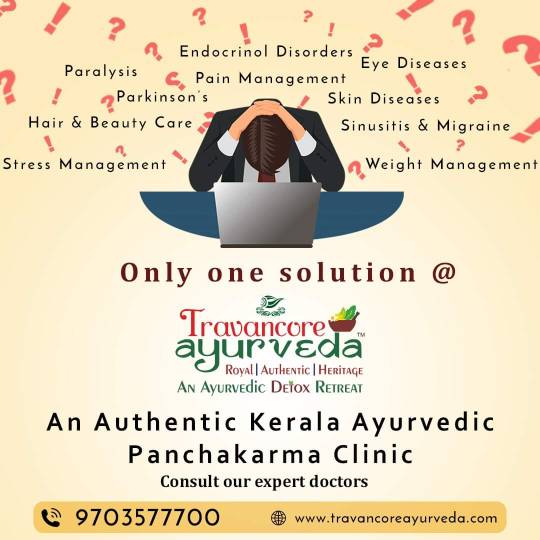
Best Ayurvedic Hospital in Hyderabad: Authentic Panchakarma Treatments from Experienced Ayurvedic Doctors in Hyderabad. ✔NABH Accredited Clinic. Call @ +91 9703577700.
#best ayurvedic doctor in hyderabad#kerala ayurveda in hyderabad#Best Kerala Ayurvedic Panchakarma Hospital in Hyderabad#ayurvedic treatment for eye diseases#Ayurvedic treatment for Stress management in Hyderabad#Ayurvedic treatment for Weight managemennt in Hyderabad#Back Pain ayurvedic treatment in Hyderabad
0 notes
Text
Top Natural Remedies For Dry Eyes Treatment

Are you seeking natural ways to dry eye treatment? You might be curious about natural methods to ease your dry eye symptoms. While it's advisable to consult your eye doctor for vision or health concerns, several natural remedies could offer temporary relief. We have put together a collection of potent natural remedies for dry eyes. Try them; you may discover they effectively address your dry eye issues!
Dry Eye and its Symptoms
The American Optometric Association (AOA) defines dry eye as a condition where an individual lacks an adequate supply of high-quality tears to lubricate and nourish the eye. This can lead to discomfort and sometimes even pain, often manifesting as common symptoms like burning, pain, and redness. If you notice the onset of dry eye symptoms or encounter any issues with your vision, it's advisable to seek the expertise of an eye doctor. Ayurvedic treatment for dry eyes, along with some natural remedies, can help manage the symptoms of this eye condition.
Causes of Dry Eyes
Meibomian gland dysfunction (MGD) stands as the primary culprit behind dry eyes, reducing the oil content in tears. Dry eye syndrome can also result from various other factors, including blepharitis (an eyelid infection) and adverse reactions to medications like antihistamines, commonly used to manage allergies.
Additionally, dry eyes may be attributed to contact lenses, conjunctivitis (pink eye), arid weather conditions, fatigue, extended use of digital devices, or a deficiency in omega-3 fatty acids within one's diet.
Risk factors for dry eyes may include:
Impaired tear quality or quantity
Gender: Women face a higher risk due to hormonal changes (e.g., pregnancy, oral contraceptives, menopause).
Age: Individuals over 50 are more susceptible.
Environmental factors and irritants include smoke, wind, and arid climates.
Underlying medical conditions like diabetes, rheumatoid arthritis, and thyroid disorders.
Medications include decongestants, antihistamines, antidepressants, and blood pressure drugs.
Lifestyle factors: Extended screen time with infrequent blinking.
Long-term use of contact lenses.
Meibomian gland disorder, resulting in insufficient oil production and secretion.
Clogged oil glands in the eyelid characterize Blepharitis.
Previous refractive eye surgeries like LASIK.
Natural remedies for dry eyes
Here are some simple natural and popular remedies that relieve dry eye.
Minimize Exposure to Airflow
To prevent excessive tear evaporation, reduce your exposure to blowing air, which heaters, air conditioners, or fans can generate. When outdoors on a windy day, consider shielding your eyes with wraparound sunglasses. While wind isn't a primary cause of dry eyes, avoiding it can help prevent discomfort.
Maintain Adequate Hydration
It's no secret that tears are composed mainly of water, so it's essential to remain properly hydrated to support your tear production. Your tears consist of approximately 98% water, with the remaining 2% of oils, salt, and proteins. A common recommendation advises adults to consume 6–8 glasses of water (250 ml or eight fl oz) daily. However, individual water requirements can fluctuate based on activity level, overall health, and the environment. Therefore, if you're experiencing dry eyes, consider adding a glass of water to your daily intake.
Utilize a Humidifier
Heating systems and air conditioning can dry the air, leading to dry eye symptoms. To combat this, use a humidifier to reintroduce moisture into the atmosphere. Placing a pot of water on your radiator can achieve a similar effect if you don't have a humidifier.
Adjust Your Computer Screen's Position
Positioning your computer screen below eye level can alleviate dry eye symptoms. When the screen is positioned too high, your eyes widen to view it, increasing tear evaporation. Lowering the screen reduces the need for wide eye-opening, helping retain moisture.
Sandalwood (Chandana)
Sandalwood, known as Chandana, is a well-established Ayurvedic remedy, valuable for promoting healthy skin and efficiently addressing dry eye concerns. Combining sandalwood powder with castor oil and applying a thin layer around the eyelids soothes irritation and relieves dry eyes.
Amla (Indian Gooseberry)
Amla stands out for its high vitamin C content and abundant antioxidants, making it a valuable ingredient in natural remedies for dry eyes. Consuming amla or applying amla-infused oil can significantly contribute to better eye health. Amla's anti-inflammatory properties are effective in diminishing eye redness and irritation.
Triphala Eye Wash
Triphala is a blend of three fruits: amla, haritaki, and bibhitaki. An eye wash crafted from Triphala powder alleviates eye dryness and inflammation. It aids in eye cleansing and helps maintain the moisture balance of the eyes.
Ghee Eye Massage
Massaging the eyelids with pure ghee enhances blood circulation around the eyes, relieving dryness. Ghee also nurtures the delicate skin surrounding the eyes, reducing the appearance of fine lines and wrinkles. Ghee is also important for Ayurvedic cataract treatment without surgery and even for other eye problems like Glaucoma.
Draksha (Grapes)
Draksha, or grapes, possess cooling properties and anthocyanin antioxidants that alleviate eye irritation and impart moisture. Applying a paste of Draksha mixed with sugar to the eyelids and the areas around the eyes is a beneficial remedy for dry eyes.
Ghrita (Pure Ghee)
Ghrita, pure ghee derived from cow's milk, is rich in valuable fatty acids, making it an excellent natural solution for alleviating dry eye syndrome. Applying a small amount of ghee to the corners of the eyelashes and eyelids and leaving it in place for a few minutes can effectively address dryness in the eyes.
Gotu Kola
Gotu Kola is a potent herb with multifaceted health benefits, including addressing dry eyes. Creating a dry powder from Gotu Kola leaves and administering it through the nostrils, a technique known as Nasya therapy, helps cleanse the passageways to the eyes and promotes tear secretion, ultimately improving dry eye conditions.
Refrain from Alcohol Consumption
Alcohol intake can lead to dehydration and impact tear quality. A study conducted demonstrated a link between alcohol consumption and dry eye syndrome. It is advisable to limit or abstain from alcohol entirely.
Incorporate Regular Eye Breaks
During extended tasks like reading or computer use, take periodic eye breaks. Remember to look away from the screen at regular intervals. Close your eyes for a few minutes or perform slow, deliberate blinking about ten times for a few seconds. These actions can help evenly distribute your tears across the surface of your eyes.
Quit Smoking
Cigarette smoke contains over 7,000 chemicals that can irritate the eyes and compromise tear quality. Smoking significantly elevates the risk of developing dry eyes.
Address Food Intolerances
Certain individuals experience food intolerances, such as gluten, nuts, or dairy, which can trigger inflammatory reactions in the body. These reactions can also affect the eyes. If you suspect a food intolerance, try eliminating trigger foods for four weeks to assess any improvement in your dry eye symptoms.
Apply Warm Compresses
Relax with a warm compress to cleanse your eyelids and facilitate better oil flow from your eyelid glands. This can enhance tear quality and alleviate dry eye discomfort.
Lid Rinse
Gently massage your eyelids with warm water and baby shampoo to promote improved oil flow from your eyelid glands and enhance tear quality. You may also consider using a preservative-free eyelid cleanser. Ensure you clean both your upper and lower eyelids and eyelashes to remove any makeup or creams that might irritate your eyes.
Eye Drops
Ayurvedic tear eye drops can offer relief when natural tear production is insufficient. Lubricating eye drops available over the counter can help bolster your tear film, safeguarding the integrity of your eye's surface. Natural eye drops by big brands contain ingredients like Palash, Tuth Bhasma, Apamarg and more. All these ingredients can help in managing the symptoms of dry eyes.
Enhance Your Nutrition
While water forms most of your tear composition, the remaining components are crucial in maintaining tear quality. Your tear glands rely on essential nutrients to produce the oils that help reduce tear evaporation.
For instance, Omega-3 fatty acids found in fish oil can lower your risk of dry eye by 17%, relieving symptoms and enhancing tear quality.
In cases where you may not obtain these necessary nutrients naturally through your diet, eye health supplements are available. These supplements contain vital nutrients such as:
Vitamin A
Vitamin C
Vitamin D
Lutein & Zeaxanthin
Zinc
Take away
Ayurveda provides a comprehensive approach to alleviating dry eyes by tackling the underlying causes and offering Ayurvedic remedies for this condition. By integrating Ayurvedic principles into your daily regimen and seeking expert guidance, you can experience substantial and enduring relief from the discomfort associated with dry eyes.
#ayurveda#eye health#eye hospital#Ayurvedic Cataract Treatment#eye care#eyesight#ophthalmology#ayurvedic treatment
1 note
·
View note
Text
Dry eyes, a common eye condition, occur when your eyes don't produce enough tears or when the tears produced are of poor quality. Tears are essential for maintaining the health of the front surface of the eye and for providing clear vision. When the eyes become dry, it can lead to a range of problems and discomfort. Here are some of the common problems associated with dry eyes:
Discomfort and Irritation: Dry eyes can cause a persistent feeling of dryness, itching, burning, or stinging in the eyes. These sensations can be uncomfortable and distracting.
Redness: The irritation caused by dry eyes often leads to redness in the eyes, making them appear bloodshot.
Blurry Vision: Insufficient tear production can result in an unstable tear film, leading to blurry or fluctuating vision, especially when reading or using digital screens.
Sensitivity to Light: Dry eyes can make the eyes more sensitive to light, a condition known as photophobia. Bright lights, sunlight, or oncoming headlights at night may become bothersome.
Tearing: Paradoxically, dry eyes can sometimes trigger excessive tearing as the eyes try to compensate for the lack of moisture. These tears are often reflexive and do not provide the necessary lubrication.
Stringy Mucus: In some cases, dry eyes can cause the eyes to produce stringy mucus or discharge, which can be uncomfortable and affect vision.
Eye Fatigue: Dry eyes can lead to eye strain and fatigue, especially during tasks that require prolonged concentration, such as reading or using a computer.
Difficulty with Contact Lenses: Contact lens wearers may find it challenging to wear lenses comfortably when experiencing dry eyes. Dryness can lead to discomfort and even difficulty in keeping lenses in place.
Corneal Damage: If left untreated, chronic dry eyes can lead to damage to the cornea, the clear front surface of the eye. This can result in more serious issues like corneal ulcers or infections.
Decreased Quality of Life: Chronic dry eye symptoms can significantly impact a person's quality of life, making daily activities and tasks more challenging and less enjoyable.
It's important to note that dry eyes can result from various factors, including age, environmental conditions, medications, systemic diseases, and hormonal changes, among others. Treatment options for dry eyes range from over-the-counter artificial tears and lifestyle adjustments to prescription medications and medical procedures. If you are experiencing persistent dry eye symptoms, it's advisable to consult with an eye care specialist to determine the underlying cause and develop an appropriate treatment plan to alleviate your discomfort and prevent potential complications. Ayurveda provide perfect remedies for it without side effects.
0 notes
Text
Ayurvedic Treatment for Eye
Looking for the best treatment for your eyes that won't hurt you? You should read Netra Tharpanam! We heal all of the sickness in your eyes and care for them through the beauty of nature. This treatment can help keep your eyes from getting tired from using devices. The best Netra Tharpanam treatment is available at the Kottakkal Ayurvedic Medical Center, which has experts in the field and a long tradition of using what nature has given them.
#Ayurvedic massage#ayurveda treatment#ayurveda therapy#Ayurveda#ayurveda Clinic#ayurveda treatment for eye#eye treatment#eye care
0 notes
Text
Uveitis Symptoms Causes & Treatment
Uveitis, also known as middle layer inflammation, is a condition in which the eye develops. The iris, the ciliary body, and the choroid make up this structure. They control light penetration, produce aqueous hormone (fluid filling up front parts), and supply blood and oxygen to the retina.
Uveitis may be caused by infection, an autoimmune disorder, or idiopathic (of unknown origin). Uveitis can cause eye pain, blurred vision and sensitivity to light. Uveitis can be treated with steroid eye drops/injections, oral medications, or surgery in the most severe cases.
If you suspect you might have uveitis, it is important to seek immediate medical attention. Untreated, it can lead to vision loss and glaucoma.
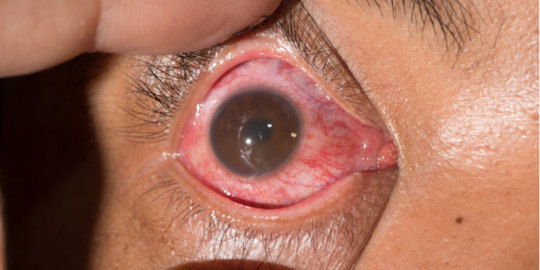
What are the symptoms of Uveitis?
There are many symptoms associated with uveitis. They can vary depending on the cause. Nevertheless, there are some common symptoms and signs associated with this eye condition:
Eye pain
Eyes are red
Blurred vision
Photophobia - Sensitivity towards light
Floaters are small spots or specks that appear to float in your field of vision.
Vision loss or decreased vision
Headaches
Tearing or watering down the eyes
Eye irritation or discomfort
Uveitis can present in various stages. Some people may not have symptoms at all, and some inflammation may only be diagnosed during routine eye exams. Consult an eye doctor if you have any of these symptoms, or have concerns about your eyes health.
What is the treatment for Uveitis?
The treatment of uveitis depends on the severity, location and cause. The goal of treatment is to reduce inflammation, alleviate symptoms, prevent complications, and preserve vision. The following are common treatments for uveitis:
Uveitis must be treated immediately to prevent complications and maintain vision. It is recommended that you have regular follow-up visits with your eye doctor to monitor the condition, adjust treatment, and report any changes.

Regular visits to your doctor are important. Advance Ayurvedic Eye Care by Sanjeevan Netralaya is extremely effective for Uveitis and all other retinal problems. Each patient's health and history is considered and a customized treatment is created for them. This ensures that there are no side effects and pain-free treatment.
#health & fitness#ayurveda#eye health#eye care#eyesight#ayurvedic eye treatment#Uveitis#eyes#retina#retina care center#retinacare#sanjevan netralaya#ayurvedic treatment#eyebrows#blue eyes
2 notes
·
View notes
Text
15% off ON BESTSELLERS DON'T MISS OUT!
Eye-Am-Special Eyecare Duo



100% Natural, royal indulgence especially curated for the Delicate, Aging, Over-worked Under-Eyes, Ajara's Age-Perfecting Duo supersedes all "Anti-Aging" Eye Treatments! Let your under-eye skin breathe in youthful vibes with this reassuring AM-to-PM care.
Night-time Rejuvenation + Day-time Revitalization! Just 2 Steps to eyes that look youthful, refreshed, well-rested.
Wish to go concealer-free? Or simply wish for something safe, reliable and effective to entrust the care of the hypersensitive, dry around-the-eye skin to? You're in for a treat!
Just 1 use and your under-eye skin will thank you. Lo and Behold, Ayurveda's choicest in Eye-Am-Special Eye Care Duo. (Rated - 4.6/5 for a reason). It does make a difference!
Try it now with a risk-free 30-Day Money-Back Guarantee!
#ayurveda#artists on tumblr#artwork#ayurvedic doctor in allahabad#ayurvedic treatment#ayurvedic medicine#ayurvedic doctor in ghaziabad#animation#ayurvedic doctor in rajkot#ayurvedicmedicine#ayurvedictreatment#pure herbs#kalyan#dombivli#Ayurveda#treatment#herbal#health#wellness#healthcare#women health#healthy lifestyle#skinnni#skintight#skincare#eyes
27 notes
·
View notes
Text
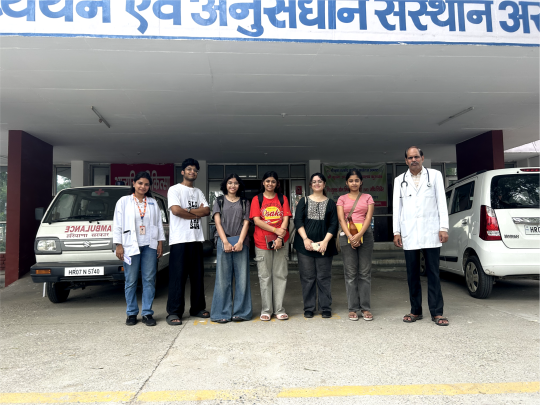
Day 2: Visiting a hospital
After a lot of infighting and straight up civil war drama rivalling the Mahabharata, our new group rose like a phoenix out of the ashes and we changed our space to Sri Krishna AYUSH. Ayurvedic Hospital. We visited the facility. It was the only medical college in Kurukshetra.


Context of the place
Shri Krishna AYUSH University, established by the Haryana Government under Act No. 25 of 2017, began its operations in the academic year 2018-19. Headquartered in Sector 8, Kurukshetra, Haryana, it is the first university of its kind in the world to offer all AYUSH courses. This university plays a pivotal role in the affiliation and regulation of Ayurveda courses across government and private colleges in Haryana.

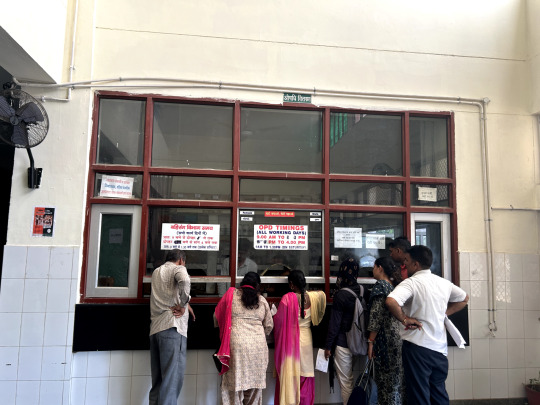
Tour of the Hospital
We walked in through the emergency block and tried to soak everything in and get a feel for the place and later found out about the main entrance. There, we spoke to the medical superintendant, Dr. Rajender Singh who introduced us to Dr. Priya, an intern who is doing PG. She gave us a tour of the place, meticulously explaining everything in great detail.


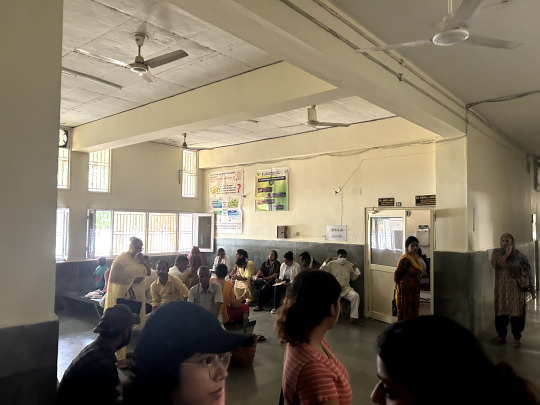

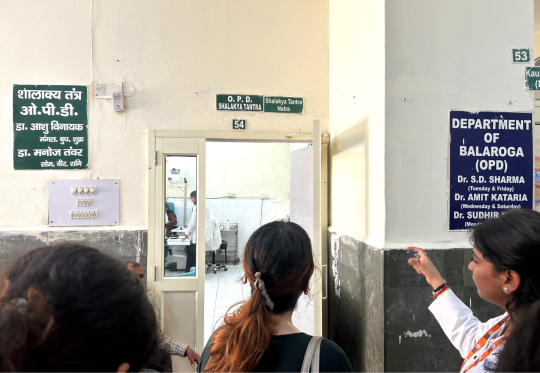
Dr. Priya started with the OPDs and explained what the purpose of each ward was. She guided us through the entire hospital starting with the lobby where patients are instructed to get a slip with their name, age and sex.
They get assigned to specific departments based on your ailment represented by a number of the slip. Later, she walked us through all the outpatient departments on the ground floor and the accompanying waiting areas. A general sense of uncleanness was observed with the washrooms and water coolers.
The following departments and wards were seen-
GROUND FLOOR
1. Reception
2. Dispensery
3. Medical Superintendent office
4. Emergency Ward
5. OT Block
6. Swasthy raksha (yoga room)
7. Stri rog OPD (gynaecology)
8. Shalya tantra OPD (stomach)
9. Shalakya OPD (eyes)
10. Shalakya OPD sub unit (nose and throat)
11. Balrog OPD (paediatrics)
12. Kriya karg OPD (child treatment)
13. Kriya OPD (physiology)
14. Kayachikitsa OPD (general medicine)
15. Dravyagun (drug testing)
16. Rasa shastra
17. Agni karma
18. Rakt Moksh
FIRST FLOOR
1. Medical record room
2. Narcotics treatment room
3. Kayachikitsa female ward
4. Deputy MS office
5. Matron office
7. Clinical Lab
8. Nurse Staff duty room
9. Panchkarma reception
10. Panchkarma OPD



Panchkarma
We then proceeded to go one floor upwards where the inpatient wards were located. Separate wards existed for male and female. The wards were mostly not occupied with a lot of empty beds. However, there was a long line which extended far beyond the waiting area outside the Panchkarma OPD. There were two people stationed on a bench managing the people and clearing any doubts they had.
Dr. Priya explained what Panchkarma was. It means to detox. It is an Ayurvedic treatment that helps cleanse and heal the body. It involves five main methods:
Vamana (Therapeutic Vomiting): Removes toxins from the stomach.
Virechana (Purgation): Cleanses the intestines using herbal laxatives.
Basti (Enema Therapy): Uses medicated oils or herbal decoctions to cleanse the colon.
Nasya (Nasal Administration): Clears the head and sinuses by applying herbal oils through the nose.
Raktamokshana (Bloodletting): Purifies the blood, traditionally done by controlled blood removal.

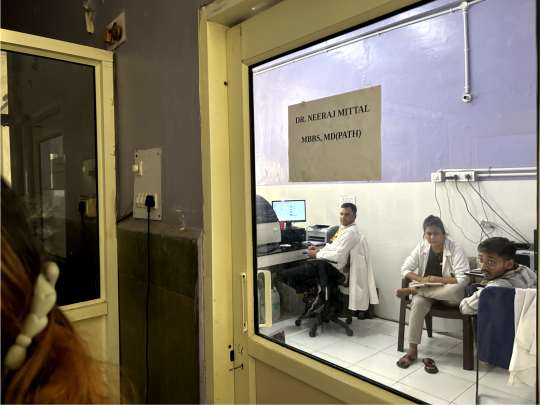

Clinical Lab
Later, we proceeded towards the pathology lab. There was a general lack of organisation. Urine samples were placed on the table out in the open. We were introduced to advanced machinery like the centrifuge. Syringes and other meds were stored in the refrigerator.

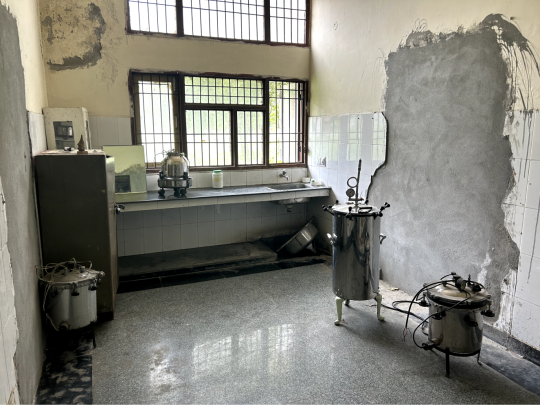



OT Block
Then we went to the Operation Theatre Block. This part, the Major OT was still under construction with exposed concrete walls, but the minor OT was functional with surgeries being conducted. Dr. Priya showed us the various instruments. There was a labor room which was not occupied.



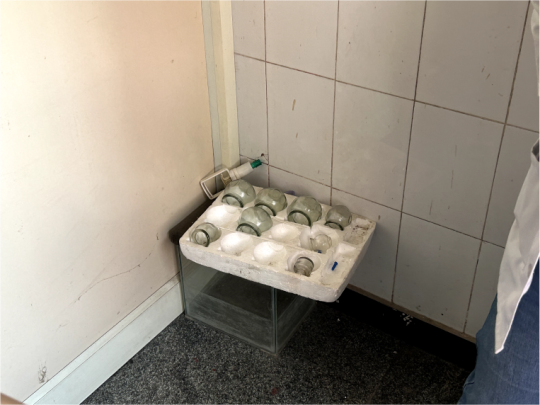
Agnikarma
Finally, we were in the agnikarma department where Dr. Priya introduced us to various instruments to treat joint pain without the need for painkillers. The shalaka was one such tool. The pointed end is heated and then briefly touched to the skin to treat various ailments like joint pain, musculoskeletal issues, and certain skin conditions. Aloe vera and turmeric were common treatment methods. Bowls were placed for cupping therapy. To our astonishment, Dr. Priya picked up a container from the shelves and showed us leeches inside. The saliva of leeches contain anticoagulants. While feeding on the blood, these substances are released into the bloodstream thereby helping in improving blood flow and reducing symptoms of varicose veins.
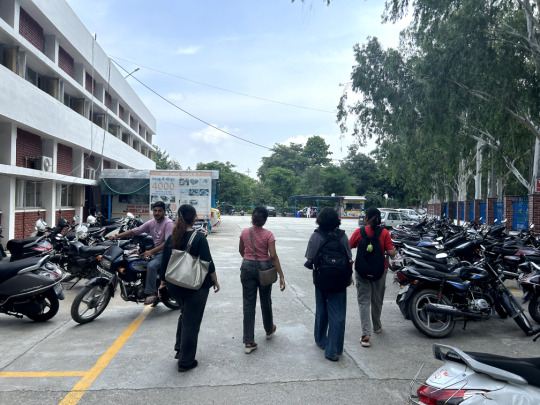
Exploring more
After the tour was over, we decided to split up and observe different areas all over the hospital. We made a list of all the equipments, items, and other stuff kept inside every ward. Then we started observing the people around us.



Since we had enough information about the structure of the hospital, and we were tired and hungry, we decided to leave and come back tomorrow to uncover more. bye.
3 notes
·
View notes
Text
The Best Shirodhara Treatment: A Comprehensive Guide to This Ancient Ayurvedic Practice
Shirodhara is a revered Ayurvedic therapy that involves pouring a steady stream of warm herbal oil or other therapeutic liquids over the forehead, particularly on the "third eye" area.
This ancient practice, rooted in Indian holistic healing traditions, aims to promote mental clarity, alleviate stress, and balance the doshas—Vata, Pitta, and Kapha. Shirodhara is not merely a relaxation technique; it is a profound treatment that offers a multitude of physical and psychological benefits.
To truly appreciate and select the Best Shirodhara treatment in Ahmedabad, one must understand its history, benefits, and the specifics of the treatment process.
The Origins and Philosophy of Shirodhara
Shirodhara, derived from the Sanskrit words "Shiro" (head) and "Dhara" (flow), is a part of Panchakarma, the five-fold Ayurvedic detoxification programme.
This therapy has been practised for thousands of years, with its origins tracing back to ancient Ayurvedic texts. The primary philosophy behind Shirodhara is the principle of balance.
Ayurveda posits that health and wellness depend on a delicate balance between the mind, body, and spirit. Shirodhara is designed to calm the mind and enhance the function of the central nervous system, leading to overall equilibrium.
Historically, Shirodhara was used to treat conditions related to the head, including migraines, insomnia, and anxiety.
The continuous flow of warm oil is believed to have a deeply meditative effect, helping to release pent-up stress and tension while nourishing the scalp and hair. This holistic approach makes Shirodhara a unique and invaluable treatment in the modern wellness landscape.
The Process and Experience of Shirodhara
A typical Shirodhara session begins with a brief consultation with an Ayurvedic practitioner to determine the individual's dosha type and any specific health concerns.
The choice of oil or liquid used in Shirodhara depends on this assessment. Commonly used oils include sesame oil, coconut oil, and specially prepared herbal oils, each chosen for their unique therapeutic properties.
The treatment itself involves the patient lying on a comfortable treatment table with their eyes covered.
A specially designed vessel, called a dhara pot, is positioned above the forehead.
Warm oil is then poured in a thin, steady stream onto the forehead, oscillating rhythmically across the forehead to ensure an even distribution. The sensation is often described as deeply soothing and hypnotic, inducing a state of relaxation akin to meditation.
The duration of the oil flow typically ranges from 30 to 60 minutes, depending on the individual's needs.
After the treatment, it is customary to rest quietly to allow the benefits to fully integrate. Many recipients report immediate feelings of tranquillity and heightened mental clarity following the session.

The Benefits of Shirodhara
Shirodhara offers a plethora of benefits that extend beyond mere relaxation. The therapy is known to significantly reduce stress and anxiety levels, making it an excellent treatment for those suffering from chronic stress or burnout.
The gentle, consistent flow of oil stimulates the hypothalamus, which helps regulate hormones and can lead to improved sleep patterns and mood stabilisation.
Additionally, Shirodhara can improve cognitive functions such as memory and concentration by calming the mind and reducing mental fatigue.
The therapy is also beneficial for various skin and scalp conditions; the herbal oils nourish the scalp, promoting healthy hair growth and alleviating conditions such as dandruff.
For those with neurological disorders, Shirodhara has shown promise in alleviating symptoms associated with conditions like hypertension, migraines, and vertigo. The therapy’s ability to calm the nervous system and enhance blood circulation contributes to these therapeutic effects.
Choosing the Best Shirodhara Treatment
To ensure the best Shirodhara experience, it is essential to select a reputable Ayurvedic clinic with certified practitioners.
The quality of the oils and the expertise of the practitioner play crucial roles in the effectiveness of the treatment. Look for clinics that offer personalised treatments tailored to individual dosha types and specific health concerns.
Reading reviews and testimonials from previous clients can provide insights into the clinic’s reputation and the experiences of others.
Additionally, some modern wellness centres offer Shirodhara as part of a comprehensive Ayurvedic treatment package, which may include dietary recommendations, yoga, and other therapies to enhance overall well-being.
Conclusion
Shirodhara is more than just an Ayurvedic therapy; it is a holistic experience that rejuvenates the mind, body, and spirit.
Whether you seek relief from stress, improved mental clarity, or holistic healing, the best Shirodhara treatment in Ahmedabad can offer profound benefits.
By understanding the origins, process, and benefits of Shirodhara, and by choosing a reputable clinic, you can fully immerse yourself in this ancient practice and enjoy its transformative effects.
#panchakarma treatment in ahmedabad#ayurvedic doctor in ahmedabad#basti treatment in ahmedabad#ayurvedic treatment in ahmedabad
2 notes
·
View notes
Text
Dry Eye Syndrome – How Ayurveda Can Help?

Are your eyes feeling parched and begging for relief? Dry eye, the condition that leaves you yearning for moisture, affects countless individuals worldwide. We will dig into the causes, symptoms, treatments, and lifestyle modifications that will drench your eyes in soothing relief.
What Is Dry Eye Syndrome?
Dry eye syndrome, also known as Kerato-conjunctivitis sicca is one of the most frequently encountered eye diseases characterized by insufficient lubrication or moisture in the surface of the eyes. The disease affects affecting nearly 5-35 % of people worldwide.
It occurs when the eye produces insufficient tears or the tears get evaporated quickly leading to dryness, blurring of vision, and other discomforts.
What Causes Dry Eye?
Tears are produced by certain special glands situated in the eyes. Any factors that lead to instability in the eyes result in dry eyes. The factors contributing to the formation of dry eye are:
Autoimmune disorders.
Environmental conditions such as extreme heat, dust, wind, and moisture.
Excessive use of contact lenses.
Hormonal changes in the body.
Certain medications.
Complications of ocular surgeries.
Excessive use of computers, television, and other gadgets.
Lack of sleep and dehydration.
Dry eye is more prone in patients with diseases such as diabetes mellitus, rheumatoid arthritis, thyroid dysfunction, etc.
Symptoms of Dry Eye
The condition presents with varying severity affecting one or both eyes. The commonly presented symptoms are:
A feeling of dryness or foreign body sensation over the eye.
Redness, burning sensation, and irritation of eyes.
Mucus discharge from the eyes.
Blurred vision.
Sensitivity towards a bright light.
Foreign body sensation over the eyes.
Pain in eyes.
Difficulty in wearing contact lenses.
What is Dry Eye in Ayurveda?
In Ayurveda, dry eye can be correlated with the condition Sushakshipaka. As per Ayurvedic principles, the condition occurs due to the imbalance of vata and pitta dosha resulting in a reduction in tear secretion and changing the quality of tears.
Due to exposure to harsh environmental conditions, excessive straining, inadequate or troublesome sleep, etc, the doshas get vitiated resulting in symptoms like dryness of the eyes, blurring of vision, difficulty in blinking eyes, etc.
How Ayurveda Manages Dry Eye Syndrome.
Ayurveda aims to restore imbalanced Vata and Pitta Dosha and improve the overall health of the eyes. Here are some of the approaches that can be opted for:
Nasyam: Instilling medicated oils or ghee into the nasal passage improves tear production and reduces dryness. Nasyam is considered the best panchakarma treatment for the disease above the neck.
Tarpanam: The procedure in which the medicated ghee is poured into the eye pits and after creating a small dam around the eyes. It nourishes and lubricates the eyes reducing the symptoms.
Parisekam: Eye wash or irrigation is the procedure in which water boiled using medicinal herbs is used for cleansing the eyes.
Snehapana: Internal administration of medicinal supplements like ghee etc helps in reducing the symptoms.
Anjana: The application of collyrium having vata and pitta hara properties is beneficial in the management of the disease.
Eye drops Instillation of ayurvedic medicinal supplements with cooling and lubricating properties.
Along with the above therapies, other external Ayurveda therapies such as Putapaka, Aschotana, Bidalaka, and Shirodhara are useful in the management of dry eye.
Yoga practices can also help to reduce eye strain and also build up the stamina of eye muscles.
Lifestyle Modifications
Drink an adequate amount of water throughout the day to stay hydrated.
Make a conscious effort to blink your eye frequently, especially during screen time or activities that require intense focus.
Take 5-10 minutes of intervals during extended screen time.
Maintain a proper distance between the eyes and the working gadget to avoid straining of eyes.
Adjust the humidity and moisture of the air in heated and air-conditioned rooms.
Use sunglasses or goggles while going outside.
Avoid smoking, allergens, eye rubbing, and other factors that worsen the situation.
Include food rich in vitamin A, leafy vegetables, carrots, fish, and flax seeds.
Conclusion
Ayurveda has been used for many centuries to manage various eye problems including cataract, glaucoma, dry eyes syndrome and in treating various muscular degenerative diseases. At Ayurclinic Melbourne, we provide a systematic analysis of patients followed by various diagnostic procedures to ascertain the level of intensity of the dryness in the eyes. Our expert team of Ayurveda practitioners indulges in various eye care routine practices to achieve the goal of nourishing your vision.
Start your journey towards comprehensive wellness with our unique range of Ayurvedic eye care solutions. For expert ayurvedic consultation and treatment process, call us @ +61 3 9078 2940 and schedule and appointment.
#ayurveda#health#ayurvedicmedicine#eyes#eye health#eye care#massage#melbourne#theraphy#alternative medicine#ayurveda treatment
0 notes
Text

BAMS Admission in Saharanpur, UP (2024-2025)
In the heart of Uttar Pradesh lies Saharanpur, a city where tradition meets innovation, and the ancient science of Ayurveda takes center stage. For aspiring healers, the journey begins with the pursuit of a BAMS (Bachelor of Ayurvedic Medicine and Surgery) degree. In this guide, we unveil the steps and opportunities for BAMS admission in Saharanpur for the academic year 2024-2025.
Choosing Saharanpur for BAMS: A Unique Blend of Tradition and Modernity
Rich Ayurvedic Heritage:
Saharanpur boasts a rich heritage in Ayurveda, making it an ideal destination for those seeking to immerse themselves in the traditional healing sciences.
Innovative Academic Institutions:
Explore the city's academic institutions that seamlessly blend traditional wisdom with modern educational approaches, offering students a comprehensive learning experience.
Navigating the Admission Process
Eligibility Criteria:
Ensure that you meet the eligibility criteria, typically a 10+2 pass with Physics, Chemistry, Biology/Biotechnology, and English. Check the specific requirements of the colleges you are interested in.
Stay Informed:
Keep a close eye on official websites, local newspapers, and educational portals for announcements related to BAMS admissions.
Entrance Exams:
Identify the relevant entrance exams for BAMS in Uttar Pradesh, such as NEET-UG (National Eligibility cum Entrance Test for Undergraduate).
Prepare diligently for the exams, utilizing official syllabi and previous years' question papers.
Application Process:
Once applications are open, obtain and fill out the application forms from the respective colleges.
Ensure all necessary documents are submitted within the specified deadlines.
Entrance Exam Results and Merit Lists:
Await the release of entrance exam results and merit lists.
Check the official websites for updates and your name on the merit list.
Counseling Sessions:
Shortlisted candidates are usually invited for counseling sessions.
Attend counseling to choose your preferred college and course based on your merit.
Document Verification and Admission:
After counseling, undergo document verification to confirm your admission.
Pay the admission fees within the specified time frame to secure your seat.
Embracing the BAMS Journey in Saharanpur
Immersive Learning Environment:
Experience a blend of theoretical knowledge and hands-on learning in Saharanpur's Ayurvedic colleges.
Clinical Exposure:
Benefit from clinical exposure opportunities, gaining practical insights into Ayurvedic diagnosis and treatment.
Holistic Approach to Wellness:
Saharanpur's BAMS programs emphasize a holistic approach to healthcare, nurturing not just medical skills but also a deep understanding of well-being.
Conclusion: Your Ayurvedic Odyssey Begins in Saharanpur
Embarking on the BAMS journey in Saharanpur isn't just about acquiring a degree; it's a commitment to preserving the ancient traditions of Ayurveda while embracing the advancements of modern medicine. As you step into the academic halls of Saharanpur's Ayurvedic colleges, envision yourself becoming a part of a legacy that transcends generations—one that blends the past with the future in the pursuit of holistic healing.
As the academic year 2024-2025 unfolds, may your journey in Saharanpur be marked by discovery, learning, and the unfolding of your potential as a future Ayurvedic practitioner. Best of luck on this transformative adventure!
Admission Helpline: +91 9140349449 | 9389097888
#Bams admission in shahjahanpur#Bams admission in shahjahanpur UP#Bams admission in shahjahanpur Mirzapur#admission proceedure for bams course#admission in ayurvedic college#admission guidance in uttar pradesh#ayurvedic course#BAMS admission 2024
2 notes
·
View notes
Text
Ayurveda , Doctor , Treatment , Nadi Pariksha , Medicine , Pure Herbs , Sri Sri Tattva , The Art of Living ,Sudarshan Kriya , Yoga , Meditation

Sri Sri Tattva Nadi Pariksha
youtube
“Ayurveda” is being recognized as a holistic system of medicine, Which holds that the body is the foundation of all Wisdom and Source of all Supreme Objectives of life.Ayurveda” have effective treatment for, Asthma, Mental Tension , Spinal Disorders , High blood pressure ,
Mental Stress, Spondylosis , High Cholesterol , Fatigue , Obesity , Headaches , Respiratory Problems , Heart Diseases , Migraine , Gastric Complaints , Chest Pain , Arthritis , Weight Loss , Osteoarthritis , Body Purification , Gynecological Disorders , Rheumatism , Anti-ageing , Chronic Constipation , Speech Disorders , Piles , Back Pain , Nervous Disorders , Hair Loss , Gout , Premature Graying , Skin Diseases , Psoriasis , Insomnia , Memory Loss , Pain , Gastric Problems , Immunity Problems , Anemia , Acne , Anorexia , Anxiety , Acidity , Bronchitis, Diabetes , Dyspepsia , Dysentery , Dandruff , Depression , Diarrhea , Dengue , Chikungunya , Indigestion , Urinary bladder disorder , Fungal infection , Nasal Congestion , Gum and Tooth diseases , Vitiation of blood , Burning Sensation , Oedema , Emaciation , Impotency , Inflammation , Ulcer , Thirst , Chloasma of face , Tastelessness , Pleurodria , Intercostal neuralgia , Pthisis , Vitiation of semen , Sciatica , Filariasis , Tumour , Intermittent fever , Lassitude , Hoarseness of voice , Mole , Conjunctivitis , Glaucoma , Myopia , Repeated Abortion , Duodenal ulcer , Malabsorption syndrome ,
youtube
Eczema , Flatulence , Fever , General Debility , Irregular Menstrual Cycle , Jaundice , Hepatitis , joint Pain , Kidney stone , Leucorrhea , Leukoderma ,
Liver Disorder , Menopause , Premenstrual Tension , Pyorrhea , Peptic Ulcer ,
Palpitation , Rheumatism , Ringworm , Stress Management , Sinusitis , Sore Throat , Skin Allergy , Sciatica , Sleeplessness ,Toothache , weight ,
Urinary Diseases , Vertigo , infection , Restlessness , Hypertension ,
Malarial Fever , Cough , Cold , Pimples , Black Heads , Appetite problem , Vomit , Eye problems , Abdominal fever , Abdominal lump ,
Swelling , Fibroid , Cyst , Bleeding , Infertility in men and women ,
Pneumonia , Curing Dryness , wounds, cuts, & burns .
Consult a certified Doctor for more details on Ayurvedic Treatment.
youtube
Sri Sri Tattva Ayurvedic Proprietary Medicine , Single Herbs and Classical Medicine at Glance to Promote Health and Wellness
NAOQ19
AMLAPITTARI VATI ,
AMRUTADI VATI ,
ANCHOLEAN TABLETS,
ATISARAHARA VATI ,
DEVA VATI ,
IMMUGEN TABLETS,
JANTUGHNA VATI ,
JVARA KEERTI VATI ,
KASAHARA VATI ,
LIV-ON TABLETS,
MAMATVA GRANULES ,
MEHANTAKA VATI ,
NARAYANA KALPA TABLET ,
NAVAHRIDAYA KALPA TABLETS,
OORJA FORTE TABLETS,
OORJA TABLET ,
OSPO-C TABLETS ,
PAVANAHARA VATI ,
PITTA BALANCE GRANULES ,
PRADARASHAMAKA VATI ,
PRANADA GUTIKA ,
PRATISHYAYAHARA VATI ,
PYLMUKTI OINTMENT ,
PYLMUKTI TABLET ,
QUICK HEAL CREAM ,
RAKTASHODHINI VATI ,
RAKTAVARDHINI TABLET ,
RAKTAVARDHINI SYRUP ,
SANDHIMITRA VATI ,
SHIRASHOOLARI VATI ,
SHWASA SHUDDHI VATI ,
TWAQURE OINTMENT ,
VEDANANTAKA BALM ,
VEDANANTAKA LINIMENT ,
VEDANANTAKA VATI ,
VIRECHANA VATI ,
VRIKKA SANJIVANI VATI ,
VITILWEL OINTMENT ,
VITILWEL TABLETS ,
AMLA TABLETS ,
AMRUTH TABLETS ,
ARJUNA TABLETS ,
ASHWAGANDHA TABLETS ,
ASHWAGANDHADI TABLETS ,
BRAHMI TABLETS ,
CHANDRAPRABHA VATI ,
CHITRAKADI GUTIKA TABLETS ,
DHATRI LAUH TABLETS ,
HARITAKI TABLETS ,
KAMADUDHA RASA TABLETS ,
KAPIKACCHU GRANULES ,
LAVANGADI VATI ,
NAVAYASA LAUHA TABLETS ,
NEEM TABLETS ,
NISHAMALAKI TABLETS ,
RASNADI VATI ,
SAPTHAMRUTH LAUHA TABLETS ,
SHATAVARI TABLETS ,
SHILAJIT LAUHA VATI ,
SUDARSHAN VATI ,
TRIPHALA TABLET ,
TULASI TABLET ,
VYAGHRYADI TABLET ,
YASHTIMADHU TABLET ,
GOKSHURADI GUGGULU ,
KANCHANARA GUGGULU ,
MAHAYOGRAJ GUGGULU ,
TRAYODASHANGA GUGGULU ,
AVIPATTIKARA CHURNA ,
HARIDRA KHANDA ,
HINGVASTAKA CHURNA ,
PAVANHARA CHURNA ,
SITOPALADI CHURNA ,
TALISADI CHURNA ,
TRIPHALA CHURNA ,
BRAHMA RASAYANA ,
CHITRAKAHARITAKI LEHYA ,
KUSHMANDA RASAYANA ,
NASYA NASAL INHALER ,
SRINETRA STERILE EYE DROPS,
SUDANTA TOOTH DROPS ,
KASAHARI COUGH SYRUP ,
MEDHYA RASAYANA SYRUP ,
PACHANI RASAYANA SYRUP ,
PRADARASHAMAKA SYRUP ,
RAKTASHODHINI ARISHTA ,
SARIVA SYRUP ,
USHIRA SYRUP ,
MAHATRIPHALADYA GHRITA ,
PHALASARPI ,
GOMUTRA ARKA ,
GULMAHARA ARKA ,
ORGANIC AJAMODA ARKA ,
ORGANIC TULASI ARKA,
SANDHIMITRA ARKA,
SHAKTI DROPS,
VRIKKA SANJIVANI ARKA ,
ANU TAILA,
KSHIRABALA TAILA,
NARAYANA TAILA,
PINDA TAILA,
SHISHU TAILA ,
OJASVITA RAGI,
PRADARSHAMAKA VATI,
ALOE VERA JUICE ,
AMLA JUICE,
ALOE VERA TRIPHALA JUICE,
KARELA JAMUN JUICE
KABASURA KUDINEER TABLETS,
KABASURA KUDINEER CHOORNAM ,
TURMERIC PLUS TABLETS ,
GILOY JUICE ,
GILOY TULASI JUICE
AYUSH KWATH TABLETS ,
SUDANTA TABS ,
AYUKANTI LEHYAM ,
OJASVITA GOLDEN LATTICE .
KALAMEGH TABLETS ,
AYUSH - 64 ,
SHANKHPUSHPI TABLETS ,
SUKESHA KALPA TABLETS ,
SUKESHA HAIR VITALISER CREAM ,
Giloy juice
Giloy Tulasi Juice
CHYAWANPRASH ,
ALMOND OIL VEG CAPSULE ,
EVENING PRIMROSE OIL VEG CAPSULE ,
FENUGREEK OIL VEG CAPSULE ,
FLAXSEED OIL VEG CAPSULE ,
GARLIC OIL VEG CAPSULE ,
NIGELLA OIL VEG CAPSULE ,
WHEAT GERM OIL VEG CAPSULE ,
APPLE CIDER VINEGAR JUICE ,
WHEATGRASS JUICE ,
MOORINGA JUICE ,
RAW NONI JUICE ,
Brahmi Vati Suvarnayukta
Bruhat Vata Chintamani Rasa
Mahalaxmivilas Rasa
Shwaskas Chintamani Rasa
Sootashekhar Rasa ( Gold)
Suvarna Vasant Malati
Vasant Kusumakar Rasa
Yogendra Rasa
#Rejuvenate yourself with Ayurveda and Yoga Campaign#Ayurveda#Doctor#Treatment#Nadi Pariksha#Medicine#Pure Herbs#Sudarshan Kriya#Youtube
2 notes
·
View notes